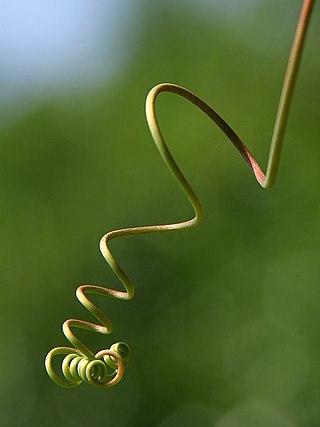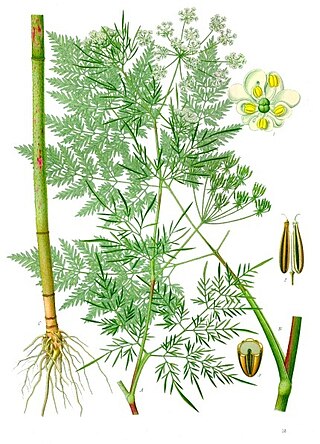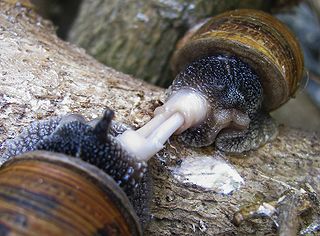Related Research Articles

Monocotyledons, commonly referred to as monocots, are grass and grass-like flowering plants (angiosperms), the seeds of which typically contain only one embryonic leaf, or cotyledon. They constitute one of the major groups into which the flowering plants have traditionally been divided; the rest of the flowering plants have two cotyledons and were classified as dicotyledons, or dicots.

Iridaceae is a family of plants in order Asparagales, taking its name from the irises. It has a nearly global distribution, with 69 accepted genera with a total of c. 2500 species. It includes a number of economically important cultivated plants, such as species of Freesia, Gladiolus, and Crocus, as well as the crop saffron.

In botany, a tendril is a specialized stem, leaf or petiole with a threadlike shape used by climbing plants for support and attachment, as well as cellular invasion by parasitic plants such as Cuscuta. There are many plants that have tendrils; including sweet peas, passionflower, grapes and the Chilean glory-flower. Tendrils respond to touch and to chemical factors by curling, twining, or adhering to suitable structures or hosts. Tendrils vary greatly in size from a few centimeters up to 27 inches for Nepenthes harryana The chestnut vine can have tendrils up to 20.5 inches in length. Normally there is only one simple or branched tendril at each node, but the aardvark cucumber can have as many as eight.

Plant reproductive morphology is the study of the physical form and structure of those parts of plants directly or indirectly concerned with sexual reproduction.
In biology, gonochorism is a sexual system where there are two sexes and each individual organism is either male or female. The term gonochorism is usually applied in animal species, the vast majority of which are gonochoric.
Dioecy is a characteristic of certain species that have distinct unisexual individuals, each producing either male or female gametes, either directly or indirectly. Dioecious reproduction is biparental reproduction. Dioecy has costs, since only the female part of the population directly produces offspring. It is one method for excluding self-fertilization and promoting allogamy (outcrossing), and thus tends to reduce the expression of recessive deleterious mutations present in a population. Plants have several other methods of preventing self-fertilization including, for example, dichogamy, herkogamy, and self-incompatibility.

Sequential hermaphroditism is one of the two types of hermaphroditism, the other type being simultaneous hermaphroditism. It occurs when the organism's sex changes at some point in its life. A sequential hermaphrodite produces eggs and sperm at different stages in life. Sequential hermaphroditism occurs in many fish, gastropods, and plants. Species that can undergo these changes do so as a normal event within their reproductive cycle, usually cued by either social structure or the achievement of a certain age or size. In some species of fish, sequential hermaphroditism is much more common than simultaneous hermaphroditism.
Androdioecy is a reproductive system characterized by the coexistence of males and hermaphrodites. Androdioecy is rare in comparison with the other major reproductive systems: dioecy, gynodioecy and hermaphroditism. In animals, androdioecy has been considered a stepping stone in the transition from dioecy to hermaphroditism, and vice versa.

Chaerophyllum bulbosum is a species of flowering plant from the carrot family and known by several common names, including turnip-rooted chervil, tuberous-rooted chervil, bulbous chervil, and parsnip chervil. It is native to Europe and Western Asia. It was a popular vegetable in the 19th century.

A hermaphrodite is a sexually reproducing organism that produces both male and female gametes. Animal species in which individuals are either male or female are gonochoric, which is the opposite of hermaphroditic.

Gynodioecy is a rare breeding system that is found in certain flowering plant species in which female and hermaphroditic plants coexist within a population. Gynodioecy is the evolutionary intermediate between hermaphroditism and dioecy.

Silene is a flowering plant genus that has evolved a dioecious reproductive system. This is made possible through heteromorphic sex chromosomes expressed as XY. Silene recently evolved sex chromosomes 5-10 million years ago and are widely used by geneticists and biologists to study the mechanisms of sex determination since they are one of only 39 species across 14 families of angiosperm that possess sex-determining genes. Silene are studied because of their ability to produce offspring with a plethora of reproductive systems. The common inference drawn from such studies is that the sex of the offspring is determined by the Y chromosome.

Solanum plastisexum is a species of bush tomato from the Australian monsoon tropics that exhibits "breeding system fluidity" – that is, it has no stable sexual expression. After its first description in 2019, the describers suggested the common name of Dungowan bush tomato, in reference to Dungowan Station where it was collected.

Erophaca is a monotypic genus of the tribe Galegeae. Its only species, Erophaca baetica, is a perennial plant distributed in disjunct populations in the Mediterranean Region.

Simultaneous hermaphroditism is one of the two types of hermaphroditism, the other type being sequential hermaphroditism. In this form of hermaphroditism an individual has sex organs of both sexes and can produce both gamete types even in the same breeding season.
Gynomonoecy is defined as the presence of both female and hermaphrodite flowers on the same individual of a plant species. It is prevalent in Asteraceae but is poorly understood.

Monoecy is a sexual system in seed plants where separate male and female cones or flowers are present on the same plant. It is a monomorphic sexual system comparable with gynomonoecy, andromonoecy and trimonoecy, and contrasted with dioecy where individual plants produce cones or flowers of only one sex and with bisexual or hermaphroditic plants in which male and female gametes are produced in the same flower.

A sexual system is a distribution of male and female function across organisms in a species. The terms reproductive system and mating system have also been used as synonyms.
Solanum cerasiferum is a species of plant in the nightshade family. It is native to tropical Africa.
Trimonoecy, also called polygamomonoecy, is when male, female, and hermaphrodite flowers are on the same plant. Trimonoecy is rare.
References
- ↑ Allaby, Michael (2015), "andromonoecious", A Dictionary of Ecology, Oxford University Press, doi:10.1093/acref/9780191793158.001.0001, ISBN 978-0-19-179315-8 , retrieved 2021-07-06
- ↑ Torices, Rubén; Méndez, Marcos; Gómez, José María (2011). "Where do monomorphic sexual systems fit in the evolution of dioecy? Insights from the largest family of angiosperms". New Phytologist. 190 (1): 234–248. doi: 10.1111/j.1469-8137.2010.03609.x . ISSN 1469-8137. PMID 21219336.
- ↑ Wilson, Karen L.; Morrison, David A. (2000). Monocots: Systematics and Evolution: Systematics and Evolution. Csiro Publishing. p. 310. ISBN 978-0-643-09929-6.
- 1 2 Pugnaire, Francisco; Valladares, Fernando (2007-06-20). Functional Plant Ecology. CRC Press. p. 524. ISBN 978-1-4200-0762-6.
- ↑ "Definition of ANDROMONOECIOUS". www.merriam-webster.com. Retrieved 2021-09-12.
- ↑ Kouonon, L. C.; Jacquemart, A.-L.; Zoro Bi, A. I.; Bertin, P.; Baudoin, J.-P.; Dje, Y. (2009-08-11). "Reproductive biology of the andromonoecious Cucumis melo subsp. agrestis (Cucurbitaceae)". Annals of Botany. 104 (6): 1129–1139. doi:10.1093/aob/mcp196. ISSN 0305-7364. PMC 2766191 . PMID 19671577.
- ↑ Huang, Shuang-Quan (2003). "Flower dimorphism and the maintenance of andromonoecy in Sagittaria guyanensis ssp. lappula (Alismataceae)". New Phytologist. 157 (2): 357–364. doi: 10.1046/j.1469-8137.2003.00676.x . ISSN 1469-8137. PMID 33873632.
- ↑ Kellogg, Elizabeth A. (2015). Flowering Plants. Monocots: Poaceae. Springer. p. 93. ISBN 978-3-319-15332-2.
- 1 2 3 Glover, Beverley (2014). Understanding Flowers and Flowering Second Edition. Oxford University Press. p. 139. ISBN 978-0-19-966159-6.
- ↑ Reuther, Kerstin; Claßen-Bockhoff, Regine (2013). "Andromonoecy and developmental plasticity in Chaerophyllum bulbosum (Apiaceae–Apioideae)". Annals of Botany. 112 (8): 1495–1503. doi:10.1093/aob/mct073. ISSN 0305-7364. PMC 3828945 . PMID 23585495.
- 1 2 Casimiro-Soriguer, R.; Herrera, J.; Talavera, S. (2012). "Andromonoecy in an Old World Papilionoid legume, Erophaca baetica". Plant Biology. 15 (2): 353–359. doi:10.1111/j.1438-8677.2012.00648.x. ISSN 1435-8603. PMID 22823201.
- ↑ Lüttge, Ulrich; Cánovas, Francisco M.; Matyssek, Rainer (2016). Progress in Botany 77. Springer. p. 361. ISBN 978-3-319-25688-7.
- 1 2 Chapman, Mark A. (2019-05-30). The Eggplant Genome. Springer. p. 16. ISBN 978-3-319-99208-2.
- ↑ Fusco, Giuseppe; Minelli, Alessandro (2019). The Biology of Reproduction. Cambridge University Press. p. 135. ISBN 978-1-108-49985-9.
- ↑ Muzzalupo, Innocenzo (2012). Olive Germplasm: The Olive Cultivation, Table Olive and Olive Oil Industry in Italy. BoD – Books on Demand. pp. 76–77. ISBN 978-953-51-0883-2.
- ↑ Patiny, Sébastien (2011). Evolution of Plant-Pollinator Relationships. Cambridge University Press. p. 34. ISBN 978-1-139-50407-2.